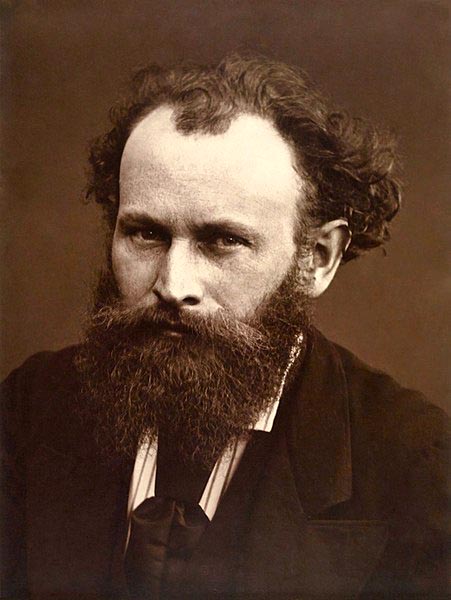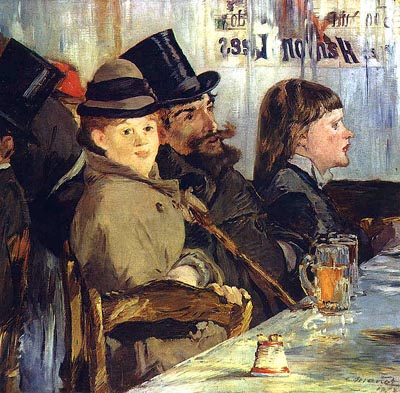 |
| Edouard Manet (Wikipedia) |
Note: Edouard Manet was a painter ahead of his time, the forerunner to the tradition-smashing movement known as "Impressionism."
Get Ready: Do you prefer paintings to look more realistic, like photographs, or should they be more impressionistic?
Edouard Manet (1832-1883) was a French painter whose work opened up new possibilities in art, in several ways.
For one thing, Manet painted modern life. Before him, many artists concentrated on scenes from the Bible, or from classical stories like Greek or Roman mythology. Other artists focused on landscapes (paintings of scenery) or still lifes (arrangements of items on a table, perhaps including flowers, food, dead animals, books, tableware, and so on).
Manet, on the other hand, painted people in modern clothing doing everyday things: drinking and dining in bars and cafes, boating on lakes, and strolling in the city, in addition to painting more traditional subjects. He often did sketches on the spot, returning to his studio to produce painted canvases.
 |
| At the Café (1878) (Wikipedia) |
His café paintings were especially notable, showing people reading, flirting, or just waiting for friends. In his At the Café (1878), a number of people are seated at a bar. One woman is looking directly at the artist (or viewer). Other people are waiting to be served. The style of these paintings is casual, reflecting the feeling of night life in Paris.
 |
| The Luncheon on the Grass (Wikipedia) |
His painting The Luncheon on the Grass was considered shocking because it showed a modern woman nude with two clothed men, having a picnic. Nudity was all right in classical paintings, and even Biblical scenes like the ones showing Adam and Eve, but real people weren't supposed to be shown that way!
Another aspect of Manet's painting that made it new and different was the way he applied the paint to the canvas. Before him, most artists made an effort to show things as realistically as possible, a technique called "Realism." Manet used his paint more freely, leading toward a style that would be called "Impressionism."
However, he did not try to show his paintings with the other Impressionists. Instead, he wanted to exhibit in the Salon, the official exhibition of the Academy of Fine Arts (Académie des Beaux-Arts) in Paris. He felt that Impressionist work should have the same respect as Realism, and not be put in a lesser category.
A bit older than the other Impressionists, Edouard Manet led the way for the major movement that was to follow.
--------Read more: https://en.wikipedia.org/wiki/%C3%89douard_Manet
Practice: Match the term to its definition below:
- canvas
- casual
- exhibit
- flirting
- lesser
- mythology
- everyday
- nude
- sketches
- strolling
- stories about the gods
- not formal; relaxed
- the rough cloth material on which a painter paints
- common; usual
- fast or incomplete drawings
- walking around in a relaxed way
- talking with a person of the opposite sex, sometimes in order to get a date
- without clothes
- organized show of art or other objects
- not as important
Answers are in the first comment below.
Submitted to the Shenzhen Daily for April 16, 2015
This lesson received 6 visits on my old site between April, 2016, and August, 2021.


Answers to the Practice: 1. c; 2. b; 3. i; 4. g; 5. j; 6. a; 7. d; 8. h; 9. e; 10. f
ReplyDelete